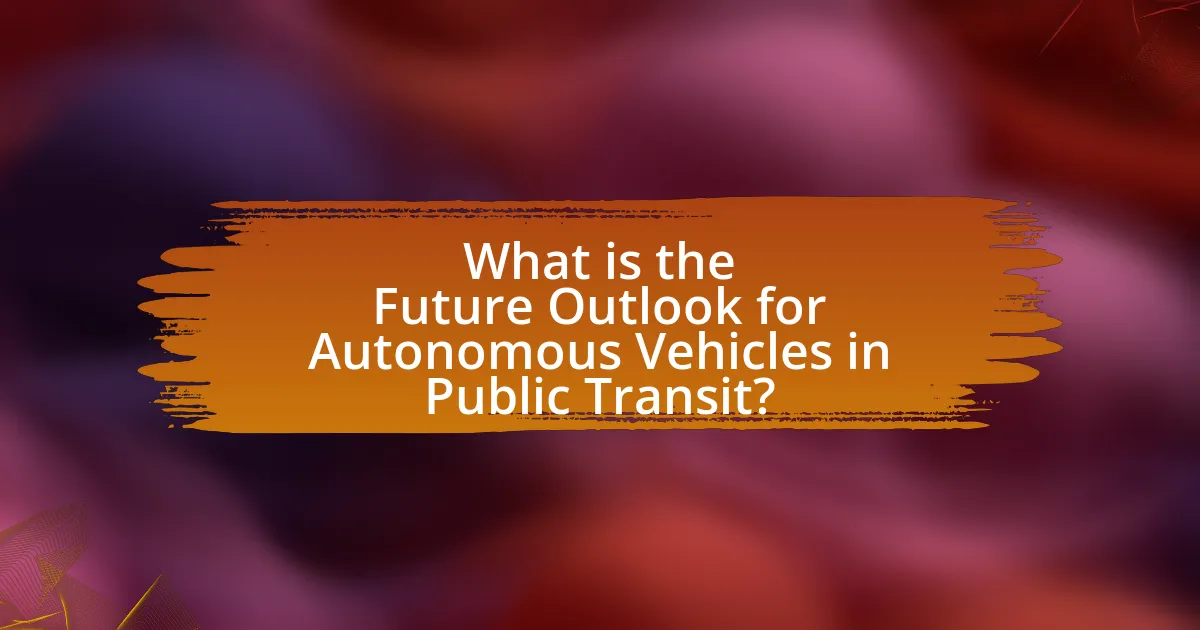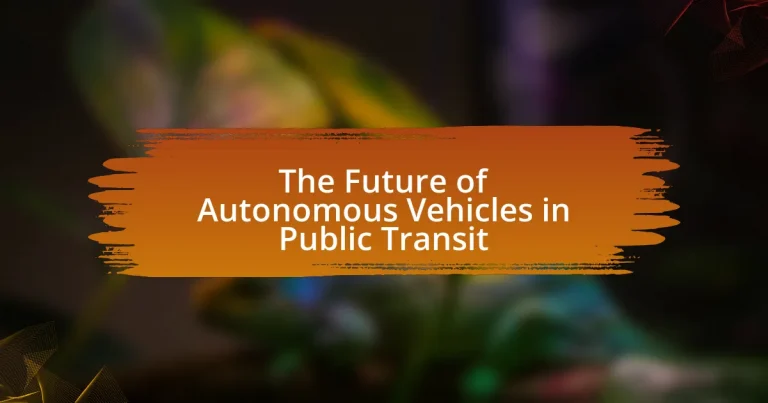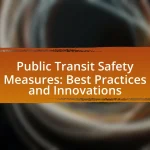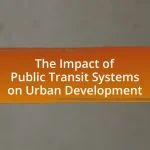Autonomous vehicles, including self-driving cars and buses, are poised to revolutionize public transit by enhancing accessibility, reducing operational costs, and improving safety. This article explores the functioning of autonomous vehicles within public transit systems, the technologies that enable their operation, and their interaction with existing infrastructure. It also examines the potential benefits of integration, such as increased ridership and efficiency, as well as the challenges faced, including regulatory hurdles and public perception. Furthermore, the article discusses how cities are preparing for this transformation through pilot programs and infrastructure updates, while highlighting the future outlook for autonomous vehicles in public transit.

What are Autonomous Vehicles and Their Role in Public Transit?
Autonomous vehicles are self-driving cars or buses equipped with technology that allows them to navigate and operate without human intervention. Their role in public transit includes enhancing accessibility, reducing operational costs, and improving safety. For instance, a study by the American Public Transportation Association indicates that autonomous vehicles can increase public transit ridership by providing first-mile and last-mile solutions, thereby connecting underserved areas to existing transit networks. Additionally, autonomous public transit systems can operate more efficiently, with reduced labor costs and optimized routes, contributing to a more sustainable urban transportation ecosystem.
How do autonomous vehicles function within public transit systems?
Autonomous vehicles function within public transit systems by providing driverless transportation solutions that enhance efficiency and accessibility. These vehicles utilize advanced technologies such as sensors, cameras, and artificial intelligence to navigate and operate safely in urban environments. For instance, cities like San Francisco and Phoenix have implemented autonomous shuttles that integrate with existing transit networks, allowing for seamless connections between different modes of transportation. Studies indicate that the deployment of autonomous vehicles can reduce operational costs by up to 30% while increasing ridership by offering more flexible and responsive service options.
What technologies enable the operation of autonomous vehicles?
Autonomous vehicles operate through a combination of technologies including sensors, artificial intelligence, machine learning, and connectivity systems. Sensors such as LiDAR, radar, and cameras provide real-time data about the vehicle’s surroundings, enabling it to detect obstacles, lane markings, and traffic signals. Artificial intelligence processes this data to make driving decisions, while machine learning algorithms improve the vehicle’s performance over time by learning from past experiences. Connectivity systems, including V2X (vehicle-to-everything) communication, allow vehicles to interact with other vehicles and infrastructure, enhancing safety and efficiency. These technologies collectively ensure that autonomous vehicles can navigate complex environments safely and effectively.
How do autonomous vehicles interact with existing public transit infrastructure?
Autonomous vehicles interact with existing public transit infrastructure by integrating with and enhancing the efficiency of transit systems. These vehicles can serve as first-mile and last-mile solutions, connecting passengers to transit hubs, thereby increasing ridership and reducing congestion. For instance, a study by the American Public Transportation Association found that integrating autonomous shuttles with bus and rail services can improve overall system accessibility and reduce wait times. Additionally, autonomous vehicles can communicate with transit signals and systems to optimize routes and schedules, leading to more efficient public transportation networks.
What are the potential benefits of integrating autonomous vehicles into public transit?
Integrating autonomous vehicles into public transit can enhance efficiency, reduce operational costs, and improve accessibility. Autonomous vehicles can optimize routes and schedules through real-time data analysis, leading to more reliable service. Additionally, studies indicate that autonomous technology can lower labor costs, as fewer drivers are needed, which can result in significant savings for transit agencies. Furthermore, autonomous vehicles can provide transportation options for individuals with disabilities or those living in underserved areas, thereby increasing overall public transit usage and promoting inclusivity.
How can autonomous vehicles improve efficiency in public transit?
Autonomous vehicles can improve efficiency in public transit by optimizing route management and reducing operational costs. These vehicles utilize advanced algorithms and real-time data to adjust routes based on passenger demand and traffic conditions, leading to more timely and responsive service. For instance, a study by the American Public Transportation Association found that integrating autonomous shuttles into existing transit systems can increase ridership by up to 30% while lowering costs by approximately 20% due to reduced labor expenses. This demonstrates that autonomous vehicles not only enhance service efficiency but also contribute to overall cost-effectiveness in public transit systems.
What impact do autonomous vehicles have on accessibility for passengers?
Autonomous vehicles significantly enhance accessibility for passengers, particularly for individuals with disabilities and the elderly. These vehicles are designed to operate without human intervention, which can provide greater independence for those who may struggle with traditional transportation options. Research indicates that autonomous vehicles can be equipped with features such as wheelchair ramps, voice-activated controls, and advanced navigation systems, making them more user-friendly for passengers with varying mobility needs. A study by the National Highway Traffic Safety Administration found that 20% of the U.S. population has a disability, highlighting the potential market for accessible autonomous transportation solutions. By improving access to public transit, autonomous vehicles can help reduce social isolation and increase mobility for underserved populations.
What challenges do autonomous vehicles face in public transit implementation?
Autonomous vehicles face significant challenges in public transit implementation, including regulatory hurdles, technological limitations, and public acceptance issues. Regulatory frameworks often lag behind technological advancements, creating uncertainty for operators and manufacturers. For instance, as of 2023, many regions lack comprehensive laws governing the operation of autonomous vehicles, which complicates their deployment in public transit systems. Technologically, autonomous vehicles must navigate complex urban environments, requiring advanced sensors and algorithms to ensure safety and efficiency. Additionally, public acceptance remains a barrier; surveys indicate that a substantial portion of the population expresses skepticism about the safety and reliability of autonomous transit options. These challenges collectively hinder the widespread adoption of autonomous vehicles in public transit systems.
What regulatory hurdles must be overcome for deployment?
Autonomous vehicles in public transit must overcome several regulatory hurdles for deployment, including safety standards, liability laws, and data privacy regulations. Safety standards require that autonomous vehicles meet specific criteria set by transportation authorities to ensure passenger and pedestrian safety. Liability laws need to be clarified to determine who is responsible in the event of an accident involving an autonomous vehicle, which complicates insurance frameworks. Additionally, data privacy regulations must be addressed to protect user information collected by these vehicles, as compliance with laws like the General Data Protection Regulation (GDPR) is essential for public trust and legal operation. These regulatory challenges must be navigated to facilitate the successful integration of autonomous vehicles into public transit systems.
How do public perceptions affect the adoption of autonomous vehicles?
Public perceptions significantly influence the adoption of autonomous vehicles by shaping consumer trust and acceptance. Research indicates that positive public perception correlates with higher willingness to use autonomous technology; for instance, a 2021 study by the American Automobile Association found that 60% of respondents expressed concern about riding in fully autonomous vehicles, highlighting a barrier to widespread acceptance. Additionally, perceptions regarding safety, reliability, and ethical implications directly impact regulatory support and investment in autonomous vehicle technology. As public confidence grows through education and successful pilot programs, adoption rates are likely to increase, demonstrating the critical role of societal attitudes in the future of autonomous vehicles in public transit.

How are Cities Preparing for Autonomous Vehicles in Public Transit?
Cities are preparing for autonomous vehicles in public transit by implementing pilot programs, updating infrastructure, and developing regulatory frameworks. For instance, cities like San Francisco and Austin have initiated trials with autonomous shuttles to assess their integration into existing transit systems. Additionally, urban planners are redesigning roadways and transit hubs to accommodate self-driving technology, ensuring safe interaction between autonomous vehicles and pedestrians. Regulatory bodies are also establishing guidelines to govern the operation of these vehicles, focusing on safety standards and data sharing. These efforts collectively aim to enhance public transit efficiency and accessibility while addressing potential challenges associated with autonomous technology.
What strategies are cities employing to integrate autonomous vehicles?
Cities are employing various strategies to integrate autonomous vehicles into their public transit systems. These strategies include developing dedicated infrastructure, such as designated lanes and charging stations, to accommodate autonomous vehicles. For example, cities like San Francisco and Austin are piloting autonomous shuttle programs that operate on fixed routes, allowing for controlled testing and data collection on performance and safety. Additionally, cities are collaborating with technology companies to create regulatory frameworks that ensure safety and efficiency, as seen in partnerships between municipalities and firms like Waymo and Cruise. Furthermore, public engagement initiatives are being implemented to educate citizens about the benefits and safety of autonomous vehicles, which is crucial for gaining public acceptance and trust.
How are pilot programs shaping the future of public transit?
Pilot programs are significantly shaping the future of public transit by allowing cities to test innovative technologies and operational strategies in real-world environments. These programs provide valuable data on user behavior, operational efficiency, and integration with existing transit systems, which are crucial for informed decision-making. For instance, cities like San Francisco and Austin have implemented pilot programs for autonomous shuttles, yielding insights that inform regulatory frameworks and infrastructure development. The success of these pilots can lead to broader adoption of autonomous vehicles, enhancing accessibility and reducing congestion in urban areas.
What role do partnerships with technology companies play in this integration?
Partnerships with technology companies are crucial for the integration of autonomous vehicles in public transit as they provide essential expertise, resources, and innovative solutions. These collaborations enable transit agencies to leverage advanced technologies such as artificial intelligence, machine learning, and data analytics, which are vital for developing safe and efficient autonomous systems. For instance, partnerships with companies specializing in sensor technology enhance vehicle navigation and obstacle detection, thereby improving operational safety. Additionally, technology firms often contribute to the development of software platforms that facilitate real-time data sharing and communication between vehicles and transit infrastructure, optimizing route planning and passenger experience. This synergy between public transit authorities and technology companies accelerates the deployment of autonomous vehicles, ensuring they meet regulatory standards and public safety requirements.
What infrastructure changes are necessary for supporting autonomous vehicles?
To support autonomous vehicles, significant infrastructure changes are necessary, including the development of advanced communication networks, dedicated lanes, and enhanced traffic management systems. Advanced communication networks, such as 5G, are essential for real-time data exchange between vehicles and infrastructure, enabling safe navigation and coordination. Dedicated lanes for autonomous vehicles can improve traffic flow and reduce the risk of accidents by separating them from traditional vehicles. Enhanced traffic management systems, utilizing AI and machine learning, can optimize traffic signals and monitor road conditions, ensuring efficient movement of autonomous vehicles. These changes are supported by studies indicating that improved infrastructure can lead to a 90% reduction in traffic accidents involving autonomous vehicles, as reported by the National Highway Traffic Safety Administration.
How will road design need to evolve for autonomous vehicle compatibility?
Road design will need to evolve by incorporating dedicated lanes, improved signage, and enhanced communication systems to ensure compatibility with autonomous vehicles. Dedicated lanes will facilitate the safe and efficient movement of autonomous vehicles, reducing the risk of accidents with human-driven vehicles. Improved signage, including digital displays, will provide real-time information to autonomous systems, enhancing navigation and decision-making. Enhanced communication systems, such as vehicle-to-infrastructure technology, will allow autonomous vehicles to interact with traffic signals and road conditions, optimizing traffic flow. These design changes are supported by studies indicating that dedicated infrastructure can significantly improve the safety and efficiency of autonomous vehicle operations.
What investments are required for smart city technologies?
Investments required for smart city technologies include funding for infrastructure, data analytics, and connectivity. Specifically, cities must allocate resources for upgrading existing infrastructure, such as roads and utilities, to support smart technologies. For instance, a report by McKinsey estimates that smart city investments could reach $1.5 trillion globally by 2025, emphasizing the need for substantial financial commitment. Additionally, investments in data analytics platforms are crucial for processing and utilizing the vast amounts of data generated by smart city systems. Connectivity investments, particularly in high-speed internet and IoT devices, are also essential to ensure seamless communication between various smart city components.

What is the Future Outlook for Autonomous Vehicles in Public Transit?
The future outlook for autonomous vehicles in public transit is promising, with significant advancements expected in technology, safety, and efficiency. As cities increasingly adopt smart transportation solutions, autonomous vehicles are projected to enhance public transit systems by reducing operational costs and improving service frequency. According to a report by the International Transport Forum, autonomous public transport could lead to a 20% reduction in operational costs and a 30% increase in service efficiency by 2030. Additionally, pilot programs in cities like San Francisco and Austin have demonstrated the feasibility of integrating autonomous shuttles into existing transit networks, indicating a trend towards wider implementation.
How might autonomous vehicles transform the public transit landscape in the next decade?
Autonomous vehicles are expected to significantly transform the public transit landscape in the next decade by enhancing efficiency, reducing operational costs, and improving accessibility. These vehicles can operate without human drivers, allowing for more flexible routing and scheduling, which can lead to increased ridership. For instance, a study by the American Public Transportation Association indicates that integrating autonomous shuttles into existing transit systems could reduce costs by up to 30% while providing service to underserved areas. Additionally, autonomous vehicles can facilitate real-time data collection and analysis, enabling transit agencies to optimize routes based on demand patterns. This transformation is further supported by advancements in technology, such as improved sensors and AI algorithms, which enhance safety and reliability in public transit systems.
What trends are emerging in the development of autonomous vehicle technology?
Emerging trends in the development of autonomous vehicle technology include increased integration of artificial intelligence for improved decision-making, advancements in sensor technology for enhanced perception, and a focus on regulatory frameworks to ensure safety and compliance. AI algorithms are becoming more sophisticated, enabling vehicles to better interpret complex environments and make real-time decisions, as evidenced by companies like Waymo and Tesla, which are continuously refining their systems. Additionally, sensor technologies such as LiDAR and computer vision are evolving, providing vehicles with a more comprehensive understanding of their surroundings, which is crucial for safe navigation. Furthermore, as autonomous vehicles become more prevalent, governments and organizations are developing regulations and standards to address safety concerns and public acceptance, highlighting the importance of a structured approach to integration into public transit systems.
How will data analytics influence the operation of autonomous public transit systems?
Data analytics will significantly enhance the operation of autonomous public transit systems by optimizing route planning, improving safety, and increasing operational efficiency. By analyzing real-time data from various sources, such as traffic patterns, passenger demand, and vehicle performance, transit authorities can make informed decisions that lead to more efficient service delivery. For instance, a study by the American Public Transportation Association found that data-driven decision-making can reduce operational costs by up to 30% while improving service reliability. This integration of data analytics allows for predictive maintenance, ensuring vehicles are serviced before failures occur, thus minimizing downtime and enhancing safety for passengers.
What lessons can be learned from early adopters of autonomous vehicles in public transit?
Early adopters of autonomous vehicles in public transit demonstrate that successful implementation requires robust infrastructure and regulatory frameworks. For instance, cities like Phoenix and San Francisco have shown that integrating autonomous vehicles necessitates collaboration with local governments and adherence to safety regulations, which helps in gaining public trust. Additionally, data from pilot programs indicate that user acceptance improves when there is clear communication about the technology’s benefits and safety measures. Furthermore, early adopters highlight the importance of continuous feedback loops from users to refine services, as seen in the case of the Waymo One service, which adjusted its operations based on rider experiences. These lessons underscore the need for strategic planning, community engagement, and adaptability in deploying autonomous vehicles in public transit systems.
What best practices have emerged from successful implementations?
Best practices that have emerged from successful implementations of autonomous vehicles in public transit include thorough stakeholder engagement, robust safety protocols, and continuous data analysis. Stakeholder engagement ensures that the needs and concerns of the community, transit authorities, and technology providers are addressed, leading to higher acceptance and smoother integration. For instance, cities like San Francisco have involved local residents in discussions about autonomous vehicle deployment, which has fostered trust and collaboration.
Robust safety protocols are critical, as demonstrated by the testing phases of companies like Waymo and Cruise, which prioritize safety measures and regulatory compliance to minimize risks. These companies have implemented extensive testing and validation processes to ensure their vehicles operate safely in diverse environments.
Continuous data analysis allows for real-time monitoring and improvement of service efficiency. For example, the deployment of autonomous shuttles in cities like Columbus, Ohio, has utilized data analytics to optimize routes and reduce wait times, enhancing user experience and operational efficiency. These best practices collectively contribute to the successful integration of autonomous vehicles in public transit systems.
How can failures inform future projects in autonomous public transit?
Failures in autonomous public transit can provide critical insights that shape future projects by highlighting design flaws, operational challenges, and user acceptance issues. For instance, the 2018 incident involving an autonomous vehicle from Uber, which resulted in a pedestrian fatality, underscored the need for improved safety protocols and better sensor technology. This failure prompted the industry to enhance testing standards and regulatory frameworks, ensuring that future autonomous systems are more reliable and secure. Additionally, analyzing failures allows developers to refine algorithms and improve decision-making processes, ultimately leading to more efficient and safer public transit solutions.
What practical steps can cities take to prepare for the future of autonomous vehicles in public transit?
Cities can prepare for the future of autonomous vehicles in public transit by investing in infrastructure that supports their integration, such as dedicated lanes and smart traffic management systems. Implementing these changes can enhance safety and efficiency, as seen in cities like San Francisco, which has begun to adapt its roadways for autonomous technology. Additionally, cities should establish regulatory frameworks that facilitate testing and deployment, ensuring compliance with safety standards while fostering innovation. Collaborating with technology companies and conducting pilot programs can provide valuable data and insights, as demonstrated by the successful trials in cities like Phoenix, where autonomous shuttles have been tested in real-world conditions. Finally, engaging the community through public awareness campaigns can help build trust and acceptance of autonomous transit solutions.
How can community engagement shape the development of autonomous transit solutions?
Community engagement can significantly shape the development of autonomous transit solutions by ensuring that these systems meet the actual needs and preferences of the users. Engaging with community members allows developers to gather valuable insights on safety concerns, accessibility requirements, and desired service features, which can directly influence design and operational decisions. For instance, a study by the Transportation Research Board highlighted that public input can lead to more user-friendly interfaces and routes that better serve underserved populations. This collaborative approach not only fosters trust and acceptance among potential users but also enhances the overall effectiveness and efficiency of autonomous transit solutions.
What resources are available for cities to educate themselves on autonomous vehicle technology?
Cities can access various resources to educate themselves on autonomous vehicle technology, including government reports, industry publications, and academic research. For instance, the U.S. Department of Transportation provides guidelines and frameworks for implementing autonomous vehicles, while organizations like the National Highway Traffic Safety Administration publish safety assessments and best practices. Additionally, industry groups such as the Autonomous Vehicle Industry Association offer insights and resources tailored for urban planners. Academic institutions also contribute through research papers and case studies, such as those published by the Transportation Research Board, which analyze the implications of autonomous vehicles on public transit systems. These resources collectively equip cities with the knowledge necessary to navigate the complexities of integrating autonomous vehicle technology into their transportation infrastructure.


